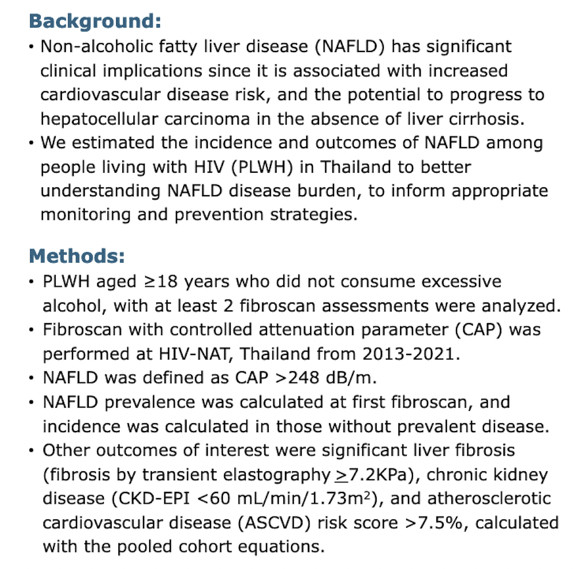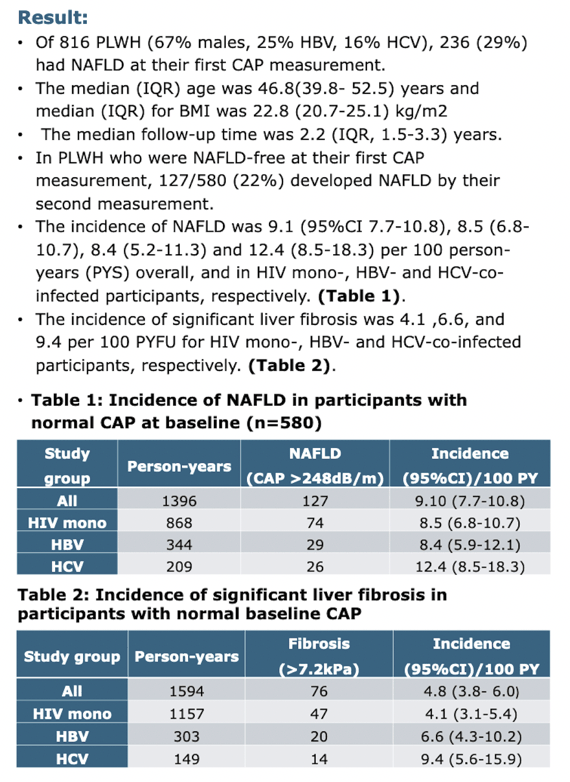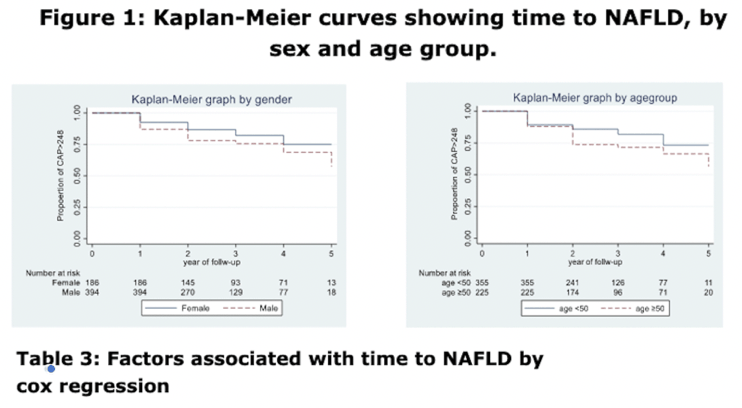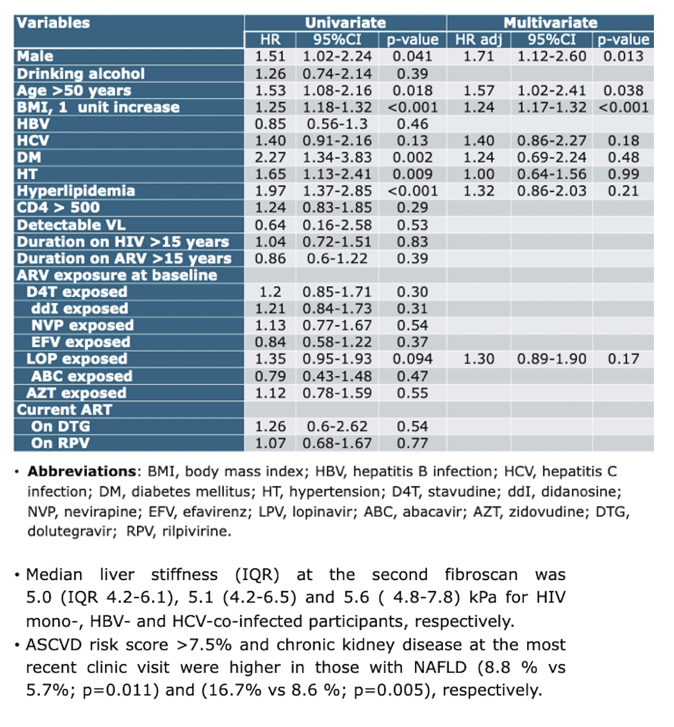 |
 |
 |
| |
Incidence and disease severity of non-alcoholic fatty
liver disease among people living with HIV in Thailand
|
| |
| |
AIDS 2022 July 29-Aug 1 Montreal
"The routine evaluation of fatty liver disease and the monitoring of its impact on cardiovascular diseases risks and other comorbidities should be integrated in HIV care.
In this Asian PLWH cohort, almost one third had fatty liver disease at first fibroscan and one fifth developed NAFLD in a median of 2.2 years."

Presenter
Tanakorn Apornpong
Authors
T. Apornpong * (1), W.M. Han (1), H.M. Su Lwin (1), K. Woratanarat (1), T. Ueaphongsukkit (1,2), S. Gatechompol (1,3), T. Wichiansan (1), S. Ubolyam (1,3), S. Phonphithak (1), P. Tangkijvanich (4), O. Putcharoen (5), S.J. Kerr (1,6,7), A. Avihingsanon (1,3)
Institutions
(1) HIV-NAT, Thai Red Cross AIDS Research Centre, Bangkok, Thailand, (2) Chulalongkorn University, Department of Medicine, Bangkok, Thailand, (3) Chulalongkorn University, Center of Excellence in Tuberculosis Faculty of Medicine, Bangkok, Thailand, (4) Chulalongkorn University, Center of Excellence in Hepatitis and Liver Cancer, Department of Biochemistry, Faculty of Medicine, Bangkok, Thailand, (5) Chulalongkorn Hospital, Emerging Infectious Disease Clinical Center, Bangkok, Thailand, (6) Chulalongkorn University, Biostatistics Excellence Centre, Faculty of Medicine, Bangkok, Thailand, (7) University of New South Wales, The Kirby Institute, Sydney, Australia
BACKGROUND: Non-alcoholic fatty liver disease (NAFLD) has significant clinical implications since it can increase the risk of cardiovascular disease and hepatocellular carcinoma without progression to liver cirrhosis. We estimated the incidence and outcome of NAFLD among people living with HIV (PLWH) in Thailand to better understanding NAFLD disease burden, so, appropriate monitoring and prevention can be addressed.
METHODS: PLWH who were not pregnant and who did not drink alcohol were enrolled.Fibroscan with controlled attenuation parameter (CAP) were performed at HIV-NAT, Thailand during 2013-2021. Participants with at least 2 fibroscan results were analysed. NAFLD was defined as CAP>248 dB/m. Outcome of interests were significant liver fibrosis (fibrosis >7.2KPa), chronic kidney disease (CKD-EPI< 60 ml/min/1.73m2), and atherosclerotic cardiovascular disease (ASCVD) risk score >7.5% using pooled equation.
RESULTS: Of 816 PLWH (67% males, 25% HBV, 16% HCV), 236 (29%) had NAFLD at first CAP measurement. Median follow-up time of 2.2 (IQR, 1.5-3.3) years, 127 PLWH (22%, 127/580) developed NAFLD at second CAP measurement. The incidence of NAFLD was 9.1 (95%CI 7.7-10.8), 8.5 (6.8-10.7), 8.4 (5.2-11.3) and 12.4 (8.5-18.3) per 100 person-years (PYS) for overall, HIV mono-, HBV- and HCV-co-infected participants, respectively. In multivariate analysis, male [hazard ratio, HR: 1.71 (95%CI 1.12-2.60), p 0.013]; age >50 years [HR: 1.57 (95%CI 1.02-2.41), p 0.038]; and BMI >23 kg/m2 [HR: 1.24 (95%CI 1.17-1.32), p <0.001] were significantly associated with NAFLD. Median liver stiffness (IQR) at the second fibroscan was 5.0 (IQR 4.2-6.1), 5.1 (4.2-6.5) and 5.6 ( 4.8-7.8) kPa for HIV mono-, HBV- and HCV-co-infected participants, respectively. The incidence of significant liver fibrosis was 4.1 ,6.6, and 9.4 per 100 PYFU for HIV mono-, HBV- and HCV-co-infected participants, respectively.
ASCVD risk score >7.5% and chronic kidney disease at the last visit was higher among NAFLD (8.8 % vs 5.7%; p=0.011) and (16.7% vs 8.6 %; p=0.005), respectively.
CONCLUSIONS: In this Asian PLWH cohort, almost one third had fatty liver disease at first fibroscan and one fifth developed NAFLD in a median of 2.2 years. The routine evaluation of fatty liver disease and the monitoring of its impact on cardiovascular diseases risks and other comorbidities should be integrated in HIV care.






|
| |
|
 |
 |
|
|